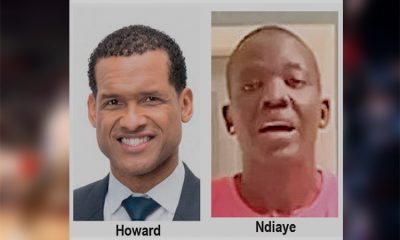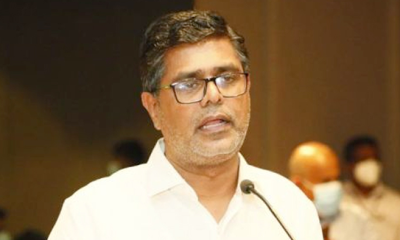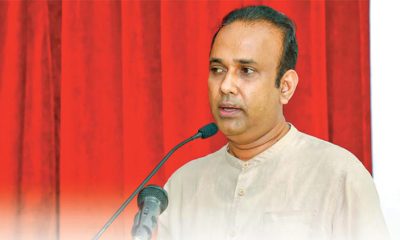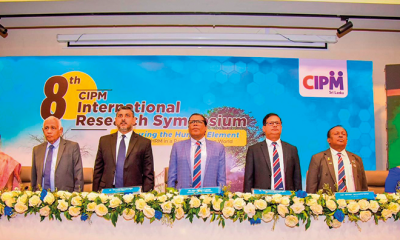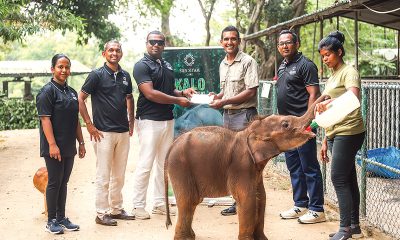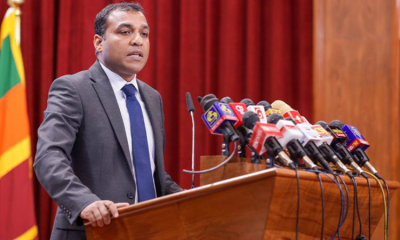Features
The next 25 years: How will the economy takeoff and how will it land?
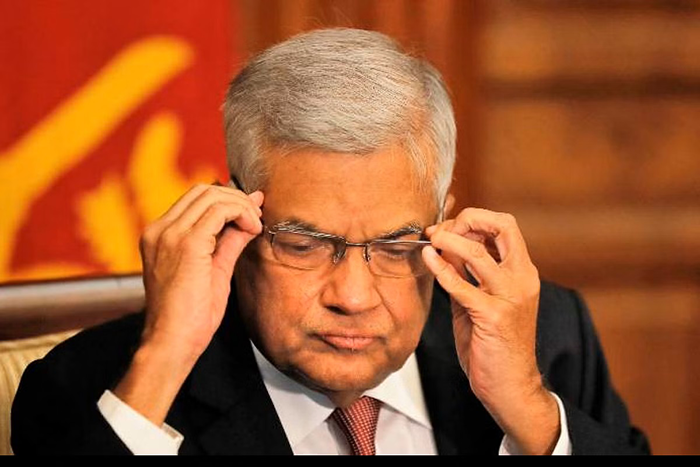
by Rajan Philips
President Wickremesinghe has a charming or annoying way, depending on who is listening, of switching between flippancy and seriousness no matter what the occasion is. Addressing the Sri Lanka Economic Summit 2022, an annual event organized by the Ceylon Chamber of Commerce, with ‘Resetting from turmoil to opportunity’ as this year’s theme, the President reportedly shocked the business audience, deadpanning, “What reforms, when we don’t have an economy!” To an audience that was apparently agog for serious revelations about an economic reform plan, the President said, “What is the plan for reform? Frankly, I have no plan for it.” But he had a program to announce and called it, ‘The Next 25 Years.’
Mr. Wickremesinghe has been harping on 25 years for some time now. That is the President’s expectation for Sri Lanka to reach economic growth and prosperity by 2048, a hundred years after becoming independent from colonial rule in 1948. The 2023 budget that passed its Third Reading on Thursday is supposed to be the launching pad for the anticipated economic recovery over the next 25 years. Hence, the President’s program: The Next 25 Years. Not to come across as being too cynical, there is nothing to substantiate this 25 year recovery program except the President’s word for it. The problem is he has a ‘word’ for everything, but little of consequence has come out of his word over the last 45 years as a parliamentarian, and four months as a parliamentary President.
He summarily wants national reconciliation achieved before independence day on February 4. We will know more about it after the All Party Conference scheduled for Monday, December 11. In the meantime, he has teased everyone with his allusion to resurrecting the District Development Councils, and used his 50th anniversary celebration as a lawyer to issue a clarion call for all fellow lawyers to come together to achieve national reconciliation. That would be fun. Getting all the lawyers to reach unanimity on something, anything. Especially, reconciliation!
Three Interventions
No presidential call, however, to all the Economists in the country to come together to help launch Sri Lanka’s 25-year economic recovery program. Economists are fewer in number and more competent in their discipline, which is also far less susceptible to pettifogging lawyerly arguments. After the President’s 2023 Budget, I have been looking at three interventions in the public domain, one by a political leader and two by noted Economists. The interventions are significant for not only what they say, but also for what they do not say.
The political leader is JVP’s Anura Kumara Dissanayake (AKD), who, as I wrote last week made a substantial speech on the economy and the political situation in the country at a public meeting in Badulla. The mainstream media has by and large ignored it. According to JVPers, mainstream media always ignores them except to dig up 1971 and 1988 whenever there is something to report on the JVP. Nonetheless, the JVP leader deserves more media coverage than a nondescript like Channa Jayasumana who seems to have wormed his way to get media coverage in spite of his abominable record in maliciously attacking Dr. Shihabdeen Shafi, the Kurunegala gynecologist, to get on the SLPP candidate list.
That aside, AKD’s Badulla speech is a graphic exposition of how terrible things are – from unaffordable prices to collapsing industries to rampant corruption. But there is nothing in the speech by way of specific remedies, except for the general assertion that elections must be held soon and the people must elect a new leadership, i.e., the JVP, to take over. He wants the country to take a leap of faith and endorse the JVP, not quite unlike President Wickremesinghe’s message to the country to take a leap of faith with him for the Next 25 Years.
The two economic intervenors I am referring to are Prof. Sirimal Abeyratne and Dr. Nimal Sanderatne, both of whom are weekly Sunday Times columnists. Abeyratne’s November 27 column is appropriately entitled, “Road to a ‘developed country’ in 2048,” and describes the budgetary vision as an “export-oriented, competitive economy led by the private sector.” The scale of the desired export expansion is ambitious – a continuous $3 billion increase in exports year over year for 25 years. Or an annual increase of 25% from the 2021 export total of $12.5 billion.
Perhaps the projected export growth is not to be deemed daunting, because after 25 years Sri Lanka’s total export value would be still under $100 billion in comparison to other export-successful Asian countries whose totals are already in the $300-$400 billion range. China is in a league of its own with an export total of $3.3 trillion. But China has a different problem, as is currently being noted by demographers. It is that the country is facing a population decline by 50% at the end of this century if not 30 years sooner. It will be quite a load off for the planet, but it is going to be an excruciating challenge for the Chinese society.
As for Sri Lanka, the annual export growth of $3 billion is to be matched by an equal yearly increase of $3 billion in Foreign Direct Investment (FDI). Sri Lanka’s FDI in 2021 dropped to a paltry $600 million, quite a way lower than Malaysia ($11.6 billion), Singapore ($99.1 billion), Thailand ($11.4 billion) and Vietnam ($15.2 billion). Curiously, the Next 25 Years are going to see exports and FDI increasing at the same rate and by the same amount to reach almost the same totals in 2048 – exports: $87 billion, and FDI: $76 billion. In contrast, the above mentioned Asian countries except Singapore have high export/FDI ratios – between 20 to 30. Is Sri Lanka going to miss out on productivity, or is productivity not meant to be a consideration for the Next 25 Years?
The more important question is how are these export and FDI growth projections going to be achieved from year to year, if they are to be the roadway for Sri Lanka to become a developed country and join the high income club with a per capita membership fee of $12,695? Prof. Abeyratne lists four pre-requisites, three of which are included in the budget. They are the introduction of a “single agency,” consolidating the current BOI, EDB, SLECIC and NEDA pillars and posts into a single window, to facilitate trade and investment; New Economic Zones in different parts of the country; and bilateral and multilateral Free Trade Area (FTA) agreements. None of which are new and have been tried and talked of before. The fourth requirement is what Prof. Abeyratne calls the “unilateral reform process,” which he considers to be “much more fundamental to export growth” than everything else. And this is what President Wickremesinghe cavalierly shot down at the Sri Lankan Economic Summit!
There is something else missing here. To achieve an annual export growth target of $3 billion, is it possible and is it not necessary to identify where this growth is going to come from? What is the contribution to growth from the already established export industries? Which among them have potential for growth and how could they be encouraged to expand? What are the industries that have plateaued but still need to be supported to maintain their production levels? Should there be an effort to identify potential new industries which are grounded on evidence and market potential, and not on snake-oil-sales-pitch about automobile-assembly plants? Would it make sense to have an export-product-mix and use it as a basis for opening target-oriented single agency, economic zones, and free trade areas?
The same day (November 27) Sunday Times column, Nimal Sanderatne hits the nail on the head by drawing attention to the enormity of the challenge of achieving the 2023 Budget objectives given “the political conditions in the country, production constraints in all sectors of the economy and the recessionary conditions abroad.” In his December 4 column, Dr. Sanderatne raises the possibility that the IMF’s $2.9 billion Extended Finance Facility may not be finalized even by March 2023. While it was overly optimistic on the part of everyone in Colombo to expect a smooth path to IMF’s support, Sanderatne is concerned about the geopolitical dynamic involving the restructuring of Sri Lanka’s debt to China and its political implications in Sri Lanka.
He alludes to something that few would have thought could become a possibility. And that is the likelihood of, as Sanderatne suggests, China blocking the IMF facility and offering an alternative “bailout package with Chinese financial and commodity assistance.” Nimal Sanderatne further suggests that based on Mahinda Rajapaksa’s speech during the budget debate, “such a programme would have the support of a large and influential component of the Government” led by Mahinda Rajapaksa and the SLPP. This would place President Wickremesinghe in a quandary, and it would also explain his scurrying for alternative funding sources in the World Bank, the ADB and Japan.
Takeoff and Landing
Geopolitical reality is what it is and it is Sri Lanka’s unique karma to have become indebted all at once to China, India, and the Paris Club lenders that includes Japan, and now has to find a way to restructure these debts without ruffling anyone’s feathers. Perhaps there is no denying that Ranil Wickremesinghe is the most suitable man for this unenviable task, but what is frustrating about him is that by his peculiar modes of operation he undermines his own suitability in the context of domestic politics. Put another way, there are serious hurdles to overcome before Sri Lanka can even get on the road to recovery, and the President has to engage the country far more substantively than by flippantly flinging mantras such as The Next Twenty Five Years.
To segue into a different theme, a January 2017 Working Paper (#641) in the Asian Development Bank Institute (ADBI) Working Paper Series, is on the subject, “Takeoffs, Landing and Economic Growth.” The paper (authored by Debayan Pakrashi and Paul Frijters) lists the takeoff and landing status of 22 South Asian and Southeast Asian economies. It provides a brief discussion on the experiences of Japan, the East Asian Tigers, the tiger cub economies, the People’s Republic of China, and India. Sri Lanka is included in the list, but not in the discussion.
Eighteen countries are identified as having had an economic takeoff including the year of takeoff. Only four countries are noted as having landed. The four countries with the takeoff and landing years are: Hong Kong (1960-1995), Japan (1946-1974), Malaysia (1968-1998), and Singapore (1966-1998). Sri Lanka’s year of takeoff is noted as 1990 but there has been no landing, at least not till 2017 when the ADBI Paper was published. We know now that the economy crash-landed in 2021. What will be its takeoff mechanism for the President’s Next 25 Year flight from its crash-landing state now. And how will it land again?
I am ending with the questions I stated in the title. There are abler people to answer them, both “as a point of method and as a point of substance,” to recall Professor W.W. Rostow, who I believe was the first to introduce the concept of economic takeoff in his celebrated 1960 monograph entitled, The Stages of Economic Growth: A Non-Communist Manifesto. I was briefly introduced to Rostow in the 1970s by Peradeniya Economics Lecturer N. Balakrishnan as part of his lectures on Economics to Engineering students. Years later I read a Marxist critique of Rostow that Hector Abhayavardhana wrote when he was living in New Delhi before his return to Sri Lanka in 1964.
Now, should I be thankful to President Wickremesinghe for rekindling old interests? Re-reading Rostow, I find several resonances in Sri Lanka’s modern economic history as well as its current takeoff challenges. Hopefully, I would be able throw some light burden on those who feel constrained to read this column. Before that, let us wait and see what the President is going to surprise us with, next week, on his other big file: National Reconciliation.
Features
The heart-friendly health minister

by Dr Gotabhya Ranasinghe
Senior Consultant Cardiologist
National Hospital Sri Lanka
When we sought a meeting with Hon Dr. Ramesh Pathirana, Minister of Health, he graciously cleared his busy schedule to accommodate us. Renowned for his attentive listening and deep understanding, Minister Pathirana is dedicated to advancing the health sector. His openness and transparency exemplify the qualities of an exemplary politician and minister.
Dr. Palitha Mahipala, the current Health Secretary, demonstrates both commendable enthusiasm and unwavering support. This combination of attributes makes him a highly compatible colleague for the esteemed Minister of Health.
Our discussion centered on a project that has been in the works for the past 30 years, one that no other minister had managed to advance.
Minister Pathirana, however, recognized the project’s significance and its potential to revolutionize care for heart patients.
The project involves the construction of a state-of-the-art facility at the premises of the National Hospital Colombo. The project’s location within the premises of the National Hospital underscores its importance and relevance to the healthcare infrastructure of the nation.
This facility will include a cardiology building and a tertiary care center, equipped with the latest technology to handle and treat all types of heart-related conditions and surgeries.
Securing funding was a major milestone for this initiative. Minister Pathirana successfully obtained approval for a $40 billion loan from the Asian Development Bank. With the funding in place, the foundation stone is scheduled to be laid in September this year, and construction will begin in January 2025.
This project guarantees a consistent and uninterrupted supply of stents and related medications for heart patients. As a result, patients will have timely access to essential medical supplies during their treatment and recovery. By securing these critical resources, the project aims to enhance patient outcomes, minimize treatment delays, and maintain the highest standards of cardiac care.
Upon its fruition, this monumental building will serve as a beacon of hope and healing, symbolizing the unwavering dedication to improving patient outcomes and fostering a healthier society.We anticipate a future marked by significant progress and positive outcomes in Sri Lanka’s cardiovascular treatment landscape within the foreseeable timeframe.
Features
A LOVING TRIBUTE TO JESUIT FR. ALOYSIUS PIERIS ON HIS 90th BIRTHDAY

by Fr. Emmanuel Fernando, OMI
Jesuit Fr. Aloysius Pieris (affectionately called Fr. Aloy) celebrated his 90th birthday on April 9, 2024 and I, as the editor of our Oblate Journal, THE MISSIONARY OBLATE had gone to press by that time. Immediately I decided to publish an article, appreciating the untiring selfless services he continues to offer for inter-Faith dialogue, the renewal of the Catholic Church, his concern for the poor and the suffering Sri Lankan masses and to me, the present writer.
It was in 1988, when I was appointed Director of the Oblate Scholastics at Ampitiya by the then Oblate Provincial Fr. Anselm Silva, that I came to know Fr. Aloy more closely. Knowing well his expertise in matters spiritual, theological, Indological and pastoral, and with the collaborative spirit of my companion-formators, our Oblate Scholastics were sent to Tulana, the Research and Encounter Centre, Kelaniya, of which he is the Founder-Director, for ‘exposure-programmes’ on matters spiritual, biblical, theological and pastoral. Some of these dimensions according to my view and that of my companion-formators, were not available at the National Seminary, Ampitiya.
Ever since that time, our Oblate formators/ accompaniers at the Oblate Scholasticate, Ampitiya , have continued to send our Oblate Scholastics to Tulana Centre for deepening their insights and convictions regarding matters needed to serve the people in today’s context. Fr. Aloy also had tried very enthusiastically with the Oblate team headed by Frs. Oswald Firth and Clement Waidyasekara to begin a Theologate, directed by the Religious Congregations in Sri Lanka, for the contextual formation/ accompaniment of their members. It should very well be a desired goal of the Leaders / Provincials of the Religious Congregations.
Besides being a formator/accompanier at the Oblate Scholasticate, I was entrusted also with the task of editing and publishing our Oblate journal, ‘The Missionary Oblate’. To maintain the quality of the journal I continue to depend on Fr. Aloy for his thought-provoking and stimulating articles on Biblical Spirituality, Biblical Theology and Ecclesiology. I am very grateful to him for his generous assistance. Of late, his writings on renewal of the Church, initiated by Pope St. John XX111 and continued by Pope Francis through the Synodal path, published in our Oblate journal, enable our readers to focus their attention also on the needed renewal in the Catholic Church in Sri Lanka. Fr. Aloy appreciated very much the Synodal path adopted by the Jesuit Pope Francis for the renewal of the Church, rooted very much on prayerful discernment. In my Religious and presbyteral life, Fr.Aloy continues to be my spiritual animator / guide and ongoing formator / acccompanier.
Fr. Aloysius Pieris, BA Hons (Lond), LPh (SHC, India), STL (PFT, Naples), PhD (SLU/VC), ThD (Tilburg), D.Ltt (KU), has been one of the eminent Asian theologians well recognized internationally and one who has lectured and held visiting chairs in many universities both in the West and in the East. Many members of Religious Congregations from Asian countries have benefited from his lectures and guidance in the East Asian Pastoral Institute (EAPI) in Manila, Philippines. He had been a Theologian consulted by the Federation of Asian Bishops’ Conferences for many years. During his professorship at the Gregorian University in Rome, he was called to be a member of a special group of advisers on other religions consulted by Pope Paul VI.
Fr. Aloy is the author of more than 30 books and well over 500 Research Papers. Some of his books and articles have been translated and published in several countries. Among those books, one can find the following: 1) The Genesis of an Asian Theology of Liberation (An Autobiographical Excursus on the Art of Theologising in Asia, 2) An Asian Theology of Liberation, 3) Providential Timeliness of Vatican 11 (a long-overdue halt to a scandalous millennium, 4) Give Vatican 11 a chance, 5) Leadership in the Church, 6) Relishing our faith in working for justice (Themes for study and discussion), 7) A Message meant mainly, not exclusively for Jesuits (Background information necessary for helping Francis renew the Church), 8) Lent in Lanka (Reflections and Resolutions, 9) Love meets wisdom (A Christian Experience of Buddhism, 10) Fire and Water 11) God’s Reign for God’s poor, 12) Our Unhiddden Agenda (How we Jesuits work, pray and form our men). He is also the Editor of two journals, Vagdevi, Journal of Religious Reflection and Dialogue, New Series.
Fr. Aloy has a BA in Pali and Sanskrit from the University of London and a Ph.D in Buddhist Philosophy from the University of Sri Lankan, Vidyodaya Campus. On Nov. 23, 2019, he was awarded the prestigious honorary Doctorate of Literature (D.Litt) by the Chancellor of the University of Kelaniya, the Most Venerable Welamitiyawe Dharmakirthi Sri Kusala Dhamma Thera.
Fr. Aloy continues to be a promoter of Gospel values and virtues. Justice as a constitutive dimension of love and social concern for the downtrodden masses are very much noted in his life and work. He had very much appreciated the commitment of the late Fr. Joseph (Joe) Fernando, the National Director of the Social and Economic Centre (SEDEC) for the poor.
In Sri Lanka, a few religious Congregations – the Good Shepherd Sisters, the Christian Brothers, the Marist Brothers and the Oblates – have invited him to animate their members especially during their Provincial Congresses, Chapters and International Conferences. The mainline Christian Churches also have sought his advice and followed his seminars. I, for one, regret very much, that the Sri Lankan authorities of the Catholic Church –today’s Hierarchy—- have not sought Fr.
Aloy’s expertise for the renewal of the Catholic Church in Sri Lanka and thus have not benefited from the immense store of wisdom and insight that he can offer to our local Church while the Sri Lankan bishops who governed the Catholic church in the immediate aftermath of the Second Vatican Council (Edmund Fernando OMI, Anthony de Saram, Leo Nanayakkara OSB, Frank Marcus Fernando, Paul Perera,) visited him and consulted him on many matters. Among the Tamil Bishops, Bishop Rayappu Joseph was keeping close contact with him and Bishop J. Deogupillai hosted him and his team visiting him after the horrible Black July massacre of Tamils.
Features
A fairy tale, success or debacle

Sri Lanka-Singapore Free Trade Agreement
By Gomi Senadhira
senadhiragomi@gmail.com
“You might tell fairy tales, but the progress of a country cannot be achieved through such narratives. A country cannot be developed by making false promises. The country moved backward because of the electoral promises made by political parties throughout time. We have witnessed that the ultimate result of this is the country becoming bankrupt. Unfortunately, many segments of the population have not come to realize this yet.” – President Ranil Wickremesinghe, 2024 Budget speech
Any Sri Lankan would agree with the above words of President Wickremesinghe on the false promises our politicians and officials make and the fairy tales they narrate which bankrupted this country. So, to understand this, let’s look at one such fairy tale with lots of false promises; Ranil Wickremesinghe’s greatest achievement in the area of international trade and investment promotion during the Yahapalana period, Sri Lanka-Singapore Free Trade Agreement (SLSFTA).
It is appropriate and timely to do it now as Finance Minister Wickremesinghe has just presented to parliament a bill on the National Policy on Economic Transformation which includes the establishment of an Office for International Trade and the Sri Lanka Institute of Economics and International Trade.
Was SLSFTA a “Cleverly negotiated Free Trade Agreement” as stated by the (former) Minister of Development Strategies and International Trade Malik Samarawickrama during the Parliamentary Debate on the SLSFTA in July 2018, or a colossal blunder covered up with lies, false promises, and fairy tales? After SLSFTA was signed there were a number of fairy tales published on this agreement by the Ministry of Development Strategies and International, Institute of Policy Studies, and others.
However, for this article, I would like to limit my comments to the speech by Minister Samarawickrama during the Parliamentary Debate, and the two most important areas in the agreement which were covered up with lies, fairy tales, and false promises, namely: revenue loss for Sri Lanka and Investment from Singapore. On the other important area, “Waste products dumping” I do not want to comment here as I have written extensively on the issue.
1. The revenue loss
During the Parliamentary Debate in July 2018, Minister Samarawickrama stated “…. let me reiterate that this FTA with Singapore has been very cleverly negotiated by us…. The liberalisation programme under this FTA has been carefully designed to have the least impact on domestic industry and revenue collection. We have included all revenue sensitive items in the negative list of items which will not be subject to removal of tariff. Therefore, 97.8% revenue from Customs duty is protected. Our tariff liberalisation will take place over a period of 12-15 years! In fact, the revenue earned through tariffs on goods imported from Singapore last year was Rs. 35 billion.
The revenue loss for over the next 15 years due to the FTA is only Rs. 733 million– which when annualised, on average, is just Rs. 51 million. That is just 0.14% per year! So anyone who claims the Singapore FTA causes revenue loss to the Government cannot do basic arithmetic! Mr. Speaker, in conclusion, I call on my fellow members of this House – don’t mislead the public with baseless criticism that is not grounded in facts. Don’t look at petty politics and use these issues for your own political survival.”
I was surprised to read the minister’s speech because an article published in January 2018 in “The Straits Times“, based on information released by the Singaporean Negotiators stated, “…. With the FTA, tariff savings for Singapore exports are estimated to hit $10 million annually“.
As the annual tariff savings (that is the revenue loss for Sri Lanka) calculated by the Singaporean Negotiators, Singaporean $ 10 million (Sri Lankan rupees 1,200 million in 2018) was way above the rupees’ 733 million revenue loss for 15 years estimated by the Sri Lankan negotiators, it was clear to any observer that one of the parties to the agreement had not done the basic arithmetic!
Six years later, according to a report published by “The Morning” newspaper, speaking at the Committee on Public Finance (COPF) on 7th May 2024, Mr Samarawickrama’s chief trade negotiator K.J. Weerasinghehad had admitted “…. that forecasted revenue loss for the Government of Sri Lanka through the Singapore FTA is Rs. 450 million in 2023 and Rs. 1.3 billion in 2024.”
If these numbers are correct, as tariff liberalisation under the SLSFTA has just started, we will pass Rs 2 billion very soon. Then, the question is how Sri Lanka’s trade negotiators made such a colossal blunder. Didn’t they do their basic arithmetic? If they didn’t know how to do basic arithmetic they should have at least done their basic readings. For example, the headline of the article published in The Straits Times in January 2018 was “Singapore, Sri Lanka sign FTA, annual savings of $10m expected”.
Anyway, as Sri Lanka’s chief negotiator reiterated at the COPF meeting that “…. since 99% of the tariffs in Singapore have zero rates of duty, Sri Lanka has agreed on 80% tariff liberalisation over a period of 15 years while expecting Singapore investments to address the imbalance in trade,” let’s turn towards investment.
Investment from Singapore
In July 2018, speaking during the Parliamentary Debate on the FTA this is what Minister Malik Samarawickrama stated on investment from Singapore, “Already, thanks to this FTA, in just the past two-and-a-half months since the agreement came into effect we have received a proposal from Singapore for investment amounting to $ 14.8 billion in an oil refinery for export of petroleum products. In addition, we have proposals for a steel manufacturing plant for exports ($ 1 billion investment), flour milling plant ($ 50 million), sugar refinery ($ 200 million). This adds up to more than $ 16.05 billion in the pipeline on these projects alone.
And all of these projects will create thousands of more jobs for our people. In principle approval has already been granted by the BOI and the investors are awaiting the release of land the environmental approvals to commence the project.
I request the Opposition and those with vested interests to change their narrow-minded thinking and join us to develop our country. We must always look at what is best for the whole community, not just the few who may oppose. We owe it to our people to courageously take decisions that will change their lives for the better.”
According to the media report I quoted earlier, speaking at the Committee on Public Finance (COPF) Chief Negotiator Weerasinghe has admitted that Sri Lanka was not happy with overall Singapore investments that have come in the past few years in return for the trade liberalisation under the Singapore-Sri Lanka Free Trade Agreement. He has added that between 2021 and 2023 the total investment from Singapore had been around $162 million!
What happened to those projects worth $16 billion negotiated, thanks to the SLSFTA, in just the two-and-a-half months after the agreement came into effect and approved by the BOI? I do not know about the steel manufacturing plant for exports ($ 1 billion investment), flour milling plant ($ 50 million) and sugar refinery ($ 200 million).
However, story of the multibillion-dollar investment in the Petroleum Refinery unfolded in a manner that would qualify it as the best fairy tale with false promises presented by our politicians and the officials, prior to 2019 elections.
Though many Sri Lankans got to know, through the media which repeatedly highlighted a plethora of issues surrounding the project and the questionable credentials of the Singaporean investor, the construction work on the Mirrijiwela Oil Refinery along with the cement factory began on the24th of March 2019 with a bang and Minister Ranil Wickremesinghe and his ministers along with the foreign and local dignitaries laid the foundation stones.
That was few months before the 2019 Presidential elections. Inaugurating the construction work Prime Minister Ranil Wickremesinghe said the projects will create thousands of job opportunities in the area and surrounding districts.
The oil refinery, which was to be built over 200 acres of land, with the capacity to refine 200,000 barrels of crude oil per day, was to generate US$7 billion of exports and create 1,500 direct and 3,000 indirect jobs. The construction of the refinery was to be completed in 44 months. Four years later, in August 2023 the Cabinet of Ministers approved the proposal presented by President Ranil Wickremesinghe to cancel the agreement with the investors of the refinery as the project has not been implemented! Can they explain to the country how much money was wasted to produce that fairy tale?
It is obvious that the President, ministers, and officials had made huge blunders and had deliberately misled the public and the parliament on the revenue loss and potential investment from SLSFTA with fairy tales and false promises.
As the president himself said, a country cannot be developed by making false promises or with fairy tales and these false promises and fairy tales had bankrupted the country. “Unfortunately, many segments of the population have not come to realize this yet”.
(The writer, a specialist and an activist on trade and development issues . )


